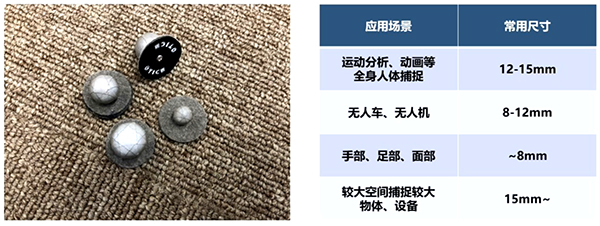A motion capture system is essentially a positioning system that typically requires the placement of tracking devices on the target object. Motion capture systems based on infrared optics mainly consist of optical cameras, motion capture software, reflective markers, POE switches, and various accessories. Reflective markers (Marker points) are a type of special sphere placed on the target object.

Motion capture systems based on infrared optical principles are divided into active and passive types. One of the differences between them lies in the reflective markers. Active markers need to be connected to a power source to emit light actively, allowing optical cameras to capture their spatial positions. In contrast, the reflective markers in passive optical systems are small spheres coated with reflective materials, which do not require any power source, wiring, or internal electronic components. These spheres are fixed on the surface of the object being captured and reflect the infrared light emitted by the camera lens. The reflected light is then received by the sensor matrix on multiple cameras to determine the 3D coordinates of the center of the spheres. This article will introduce the reflective markers (Marker points) used in passive optical motion capture systems.

Different reflective marker (Marker) types are adapted for different application scenarios. For instance, smaller objects require smaller Markers, while highly smooth surfaces necessitate Markers with a double-sided adhesive base for attachment.
Reflective markers (Marker points) Dimensions and Mounting Methods
Size

The size of the reflective markers is usually chosen based on the type and size of the object being captured. For full-body human motion capture, markers with a diameter of 12-15 mm are commonly used. For capturing fine movements of human hands, feet, or faces, smaller markers with a diameter of less than 8 mm are often used. In the field of automation, for indoor positioning and posture capture of multi-agent systems such as drones and robots, markers ranging from 8-12 mm are typically used. Additionally, if the capture scene and the objects are relatively large, markers with a diameter greater than 15 mm are used.
Fixation Method

To ensure the system's normal usage, the reflective markers (Marker points) need to be stably fixed on the surface of the captured objects. The markers are primarily fixed using hook-based bases, flat bases, and baseless methods.
Hook-and-Loop Base: This refers to a nylon fastening method, where hook-and-loop (similar to Velcro) with an adhesive back is used to attach the sensor to the surface of the object being measured.
Flat bases: Usually, double-sided adhesive is used to fix the base to a solid and smooth surface of the object being tested, or for capturing subtle human body movements.
Baseless: Reflective markers (Marker points) are directly attached to the surfaces of mechanical structures, acrylic panels, carbon fiber rods, and other materials using screws, hot glue, and similar methods,
Reflective markers (Marker points) Marker Placement

There are several important considerations when applying reflective markers (Marker points):
① To ensure the system can establish a rigid body or multi-rigid body model for the captured object, at least three reflective markers (Marker points) need to be placed on the surface of the object to define a model and obtain its 3D coordinates.
② Two reflective markers (Marker points) should not be placed too close to each other, as this can cause the system to incorrectly recognize them.
③ Reflective markers (Marker points) need to be arranged in a non-linear, non-symmetrical pattern to enable the system to correctly identify their orientation and differentiate corresponding movements.

In different application areas, such as indoor positioning for robots and drones, motion capture for film and television special effects, large-space VR training, and human gait analysis, there are various methods for attaching markers.
Motion Analysis Field

There are usually specialized human body marking templates, such as the Helen Hayes model, where reflective markers (Marker points) are placed on fixed positions on the skin or tight-fitting clothes.

Film and Animation Production

Markers are typically attached to the body using motion capture suits, and the number of markers on the body usually totals 50 or more reflective markers (Marker points). Each limb segment ensures there are 3 to 5 markers attached, with placement at the joints on bony landmarks and at the center of the limb segments to ensure that the motion capture effect remains stable and smooth without obstruction to the markers during movement.